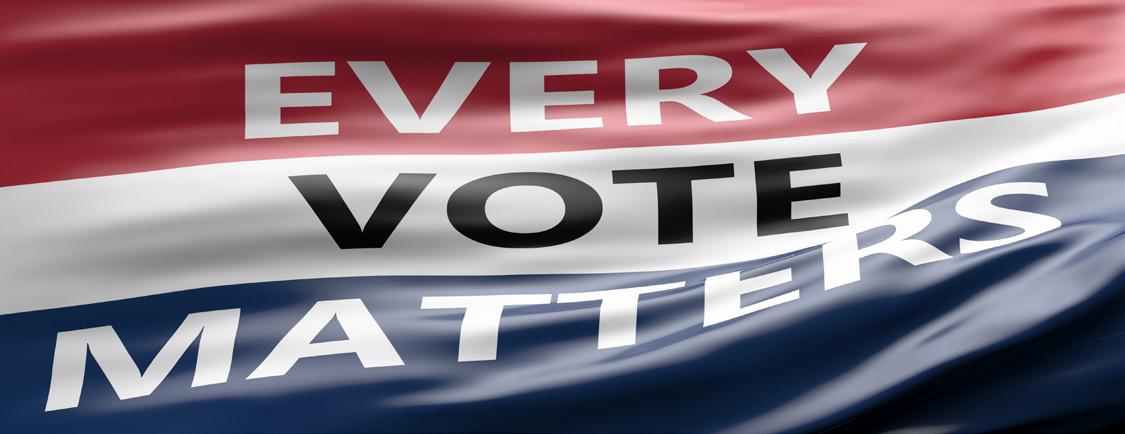
4 minute read
To Vote or Not To Vote (lesson plan
To Vote or Not to Vote From PBS News Hour Grade Level: 8-12
Estimated Time: Three or four fifty-minute class sessions.
Essential Question Why is voting an important responsibility for citizens?
Learning Objectives • Analyze the efficacy of messages encouraging people to vote • Examine the history of voting regulation since the Civil Rights Act of 1965 • Analyze voting regulation between the states and the federal government • Analyze the potential power of the Latino vote • Evaluate the importance of voting
Overview
For many Americans, voting is not a “prime time” event. Less than 60 percent of eligible voters voted in the 2012 general election. Yet, for other Americans, voting is a very meaningful, almost sacred duty. In this lesson, students will view three short films that explore the importance of voting. Each film/activity examines the topic from a different, thought-provoking perspective. Show each film in sequence and follow with the discussion questions or activity provided. Culminate with an activity that revisits students’ initial ideas about the importance of voting.
Materials
We The Voters film “First Time Voters”
We The Voters film “So You Think You Can Vote?
We The Voters film “Citizen Next”
Copies of Student Handouts: o Handout #1: Importance of Voting Survey o Handout #2: “So You Think You Can Vote?” 3-2-1 Strategy Chart o Handout #3: “Citizen Next” Graphic Organizer
Procedure:
Day 1: The Importance of Voting
Opening Activity: Organize the class into small groups. Distribute Handout #1: Importance of Voting Survey to each group. Ask them to review several websites that provide reasons for voting (examples are listed on the handout) and complete the chart. Have students meet as a class and discuss the reasons the websites were effective in encouraging voters to vote.
Film Viewing: Keep students in their small groups and have students watch the We The Voters film “First Time Voters,” more than once if necessary, and then discuss the post-viewing discussion questions below.
Post-Viewing Discussion Questions:
Discuss the following questions with students either in small groups or as a whole class. • What is the main message to José sent by the “Agent of Negativity”? • What are some of the arguments that José gives in response to the Agent’s claims? • Explain how any of the following issues mentioned in the film might directly affect you: education; healthcare; immigration; minimum wage, environment, policing, foreign policy? • The film cites the statistic that millennials are one-third of all eligible voters—83 million people. How might this voting group have a big impact on the next election?
Day 2: Challenges to Voting
Film Viewing: Distribute Handout #2: “So You Think You Can Vote?” 3-2-1 Strategy Chart. Then, show “So You Think You Can Vote?” film more than once if necessary. Then organize a “four squares activity” with a quarter of the class in each of four corners of the room. Have students share things they learned from the film and one of their questions about the film’s content with at least two people in the other groups.
Bring the class together and have students ask the questions they generated in the second section of the chart and share their most memorable moments of the film.
Day 3: Expanding the Right to Vote
Film Viewing: Distribute Handout #3: “Citizen Next” Graphic Organizer and have students watch the film “Citizen Next,” more than once if necessary. Working in small groups, have students complete the handout. To promote good question writing, have students use the summarizing points and their film notes on the organizer to formulate questions they are most curious about. Bring the students/groups back to a whole class discussion after viewing, having students pose their questions to the class.
Article Investigation: To provide students with some background on the potential of Latino and particularly millennial voters, have students read the PBS NewsHour article, “Latino millennials could be major voting bloc—if turnout is high enough.”
Post-Reading/Viewing Discussion Questions
After reading the article and viewing the film, have students discuss the following questions either in small groups or as a whole class: • What potential voting power do Latinos have in the United States? • According to the article, why does the Latino millennial population have the lowest voter turnout—behind African Americans and whites? • Why might lower voter turnout in key “toss-up states” change the outcome of this election? • The article was written in January 2016, before each major party had nominated its candidate. How might Latino voters respond to the two current presidential candidates? Have students discuss their preference for the two candidates running for president and their reasons why.
Culminating Activity: Have students return to the opening activity in this lesson where they took the “The Importance of Voting Survey.” Ask students to reflect on what they’ve learned since taking the survey and explain if any of their survey answers would change. Has their initial answer to the question, “What value do you see in voting?” changed? If so, how? If not, why not?








